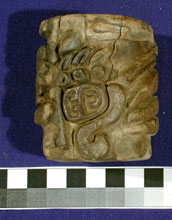Multimedia Gallery
Early "New World" Writings
Early "New World" Writings
Cylinder Seal from San Andres, Tabasco, Mexico, showing the glyphs, including 3 Ajaw, the name of a day in the 260-day Mesoamerican calendar. This is the earliest known representation on the ritual calendar date.
This cylinder seal was recovered together with a large collection of cotidian and ritual pottery, faunal remains, several human cranial fragments, greenstone artifacts and figurine fragments dating to the seventh century B.C. The seal was used to produce a printed image of a bird with two early versions of the Mesoamerican speech scroll associated with two glyphs.
The discovery was made by Mary E.D. Pohl of Florida State University, Kevin O. Pope of Geo Eco Arc Research and Christopher von Nagy of Tulane University. Pohl's research was funded primarily by the National Science Foundation. To learn more about the discovery, see NSF press release PR 02-97. (Date of Image: 1998)
Credit: Christopher von Nagy
Images and other media in the National Science Foundation Multimedia Gallery are available for use in print and electronic material by NSF employees, members of the media, university staff, teachers and the general public. All media in the gallery are intended for personal, educational and nonprofit/non-commercial use only.
Images credited to the National Science Foundation, a federal agency, are in the public domain. The images were created by employees of the United States Government as part of their official duties or prepared by contractors as "works for hire" for NSF. You may freely use NSF-credited images and, at your discretion, credit NSF with a "Courtesy: National Science Foundation" notation.
Additional information about general usage can be found in Conditions.
Also Available:
Download the high-resolution TIF version of the image. (46 KB)
Use your mouse to right-click (Mac users may need to Ctrl-click) the link above and choose the option that will save the file or target to your computer.



